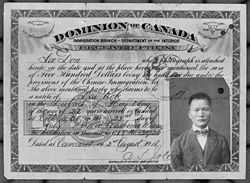Chinese Immigration Act of 1885

The Chinese Immigration Act of 1885 placed a head tax on all Chinese immigrants coming to Canada, forcing them to pay a fifty dollar fee to enter the country.[1] In 1900, the fee was raised to one hundred dollars (a substantial amount of money at that time). In 1903, the amount was raised to five hundred dollars, the equivalency of two years' wages, which was a small fortune to the Chinese immigrants as well as other Canadians at the time. Later, another law was passed, declaring that only one Chinese immigrant could come to Canada for every fifty tons (50.8 tonnes) of the ship they were travelling on, for that one voyage. That meant that only ten immigrants could come to Canada on a ship weighing five hundred tons (508 tonnes).
This act was eventually superseded in 1923 by the Chinese Immigration Act of 1923, also known as the Chinese Exclusion Act (not to be confused with the Chinese Exclusion Act of 1882), which banned Chinese immigration entirely.[2]
See also
- Chinese Canadian
- Human rights in Canada
- Immigration
- Head tax (Canada)
- Chinese Exclusion Act (United States)
- Immigration to Canada
- Moving the Mountain
- White Australia policy
References
| ||||||||||||